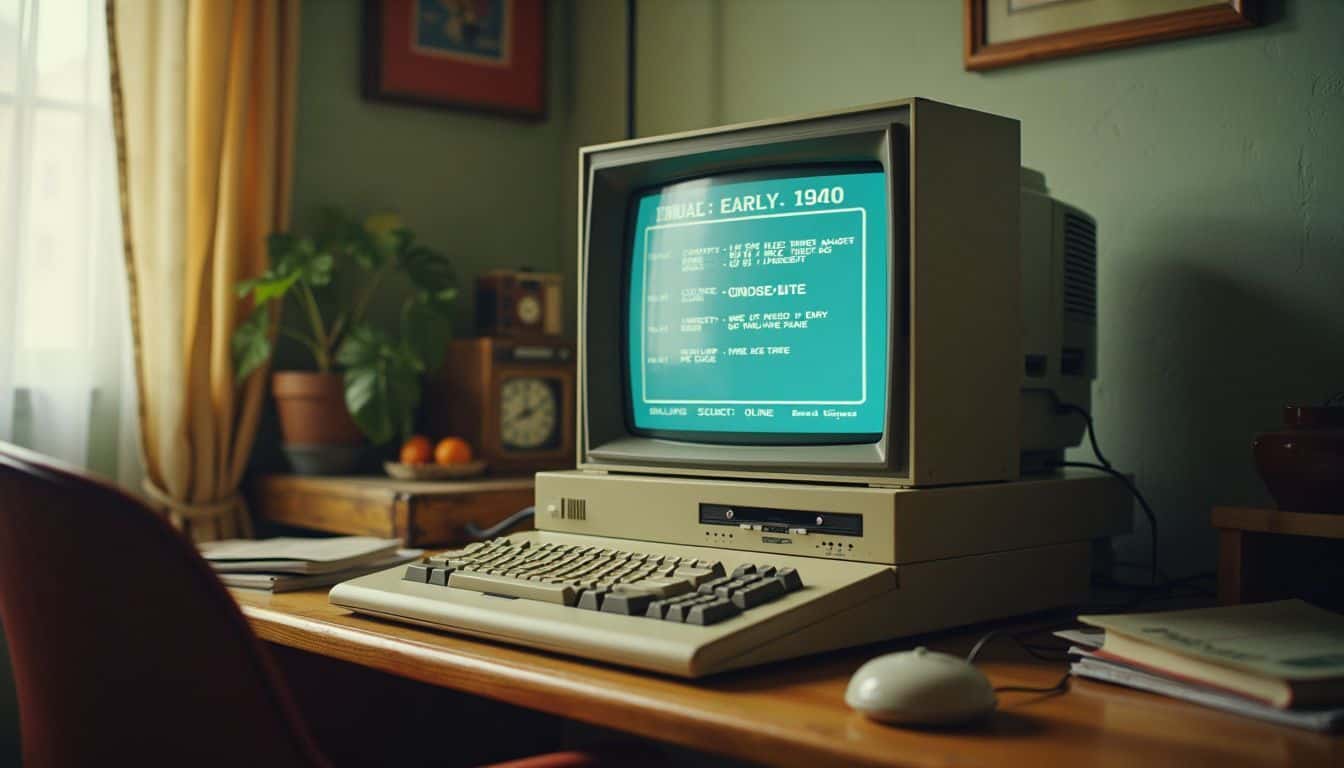Ever wondered when online gaming really kicked off? It’s a question that nags at many gamers. Believe it or not, the roots of online gaming stretch back to the 1970s. 1 This article will walk you through seven key moments that shaped the digital playground we know today.
Ready to level up your gaming history knowledge? 3
Key Takeaways
Online gaming roots go back to the 1970s with systems like PLATO, which became a hub for multiplayer games by 1978.
MUDs (Multi-User Dungeons) emerged in the late 1970s, with MUD1 launching in 1980 at Essex University, paving the way for modern MMORPGs.
Doom (1993) and Neverwinter Nights (1991) were pioneers in online gaming, introducing multiplayer “death match” modes and graphical multiplayer RPGs.
MMOGs grew rapidly in the late 1990s and early 2000s, with World of Warcraft’s 2004 debut sparking a boom in the genre.
Mobile gaming has changed how and when we play, with Netflix planning to release at least one free-to-play mobile game in 2023.
Table of Contents
The Beginnings of Online Gaming
Online gaming didn’t just pop up overnight. It’s got roots stretching back to the 1970s – way before most of us were even born! Let’s take a quick peek at how it all started….
Development of the PLATO System

PLATO, born in 1960 at the University of Illinois, was a game-changer. This system wasn’t just for learning – it became a hotbed for online gaming. By 1978, PLATO had morphed into a hub for multiplayer games and online lessons.
It’s wild to think that gaming ate up over 20% of PLATO’s usage between 1975 and 1978! 1PLATO-IV took things to the next level. By 1985, it had spread its wings to over 100 campuses worldwide. 2 This wasn’t your grandma’s computer system – it was a powerhouse that paved the way for future online gaming.
PLATO wasn’t just a system, it was a revolution in digital play.
Casino bingo games were just the tip of the iceberg compared to what PLATO could do. It laid the groundwork for the multiplayer madness we know and love today.
The Rise of MUDs (Multi-User Dungeons)

MUDs burst onto the scene in the late 1970s, changing online gaming forever. These text-based adventures let players explore virtual worlds, fight monsters, and chat with others. It all started with MUD1 in 1980 at Essex University. 3 Players typed commands to move around, pick up items, and battle foes. The game spread like wildfire among computer geeks.
MUDs paved the way for today’s massive online games. In 1984, MAD became the first MUD you could play worldwide. Then came AberMUD in 1987, which let coders easily make their own games. 3 Suddenly, MUDs popped up everywhere. Players loved the mix of storytelling, puzzles, and social interaction. These early games laid the groundwork for the MMORPGs we know today. 4
Advances in Online Gaming Technology
Online gaming tech took a giant leap forward in the 80s and 90s. New systems and networks paved the way for faster, smoother gameplay – and boy, did gamers love it!
Networked Host-Based Systems and Their Role

Networked host-based systems played a key role in early online gaming. These systems let many users connect to a central computer at once. Players could join games from different places, using terminals linked to the main host.
This setup paved the way for multiplayer action. 5ARPANET and JANET were big players in this field. They used text-based terminals to give gamers access. While graphics were basic, the thrill of playing with others was real. These networks laid the groundwork for today’s online gaming world.
They showed that people wanted to play together, even from far apart. 6
The Advent of X Window System Games
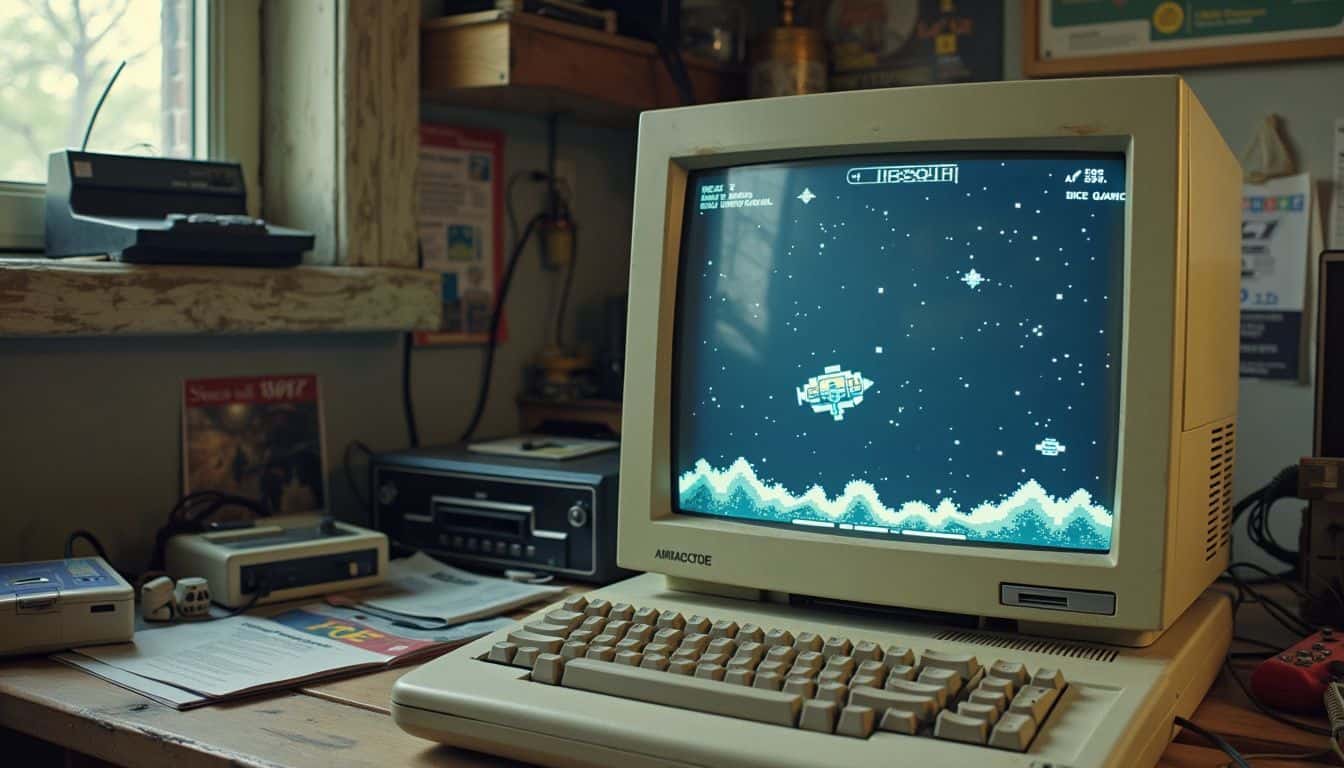
The X Window System burst onto the scene in 1986, thanks to MIT and DEC. This game-changing tech paved the way for remote display games. Xtrek led the charge as the first known space battle game that let players duke it out from different locations.
It was a 2D multiplayer marvel that set the stage for future online gaming. 8
X Window games marked a big leap forward. They let gamers play together over computer networks. This was huge! It opened up a whole new world of possibilities. Suddenly, folks could team up or face off against others miles away.
The gaming landscape would never be the same. 7
X Window System games were the spark that ignited the online gaming revolution.
Pioneers of Online Gaming
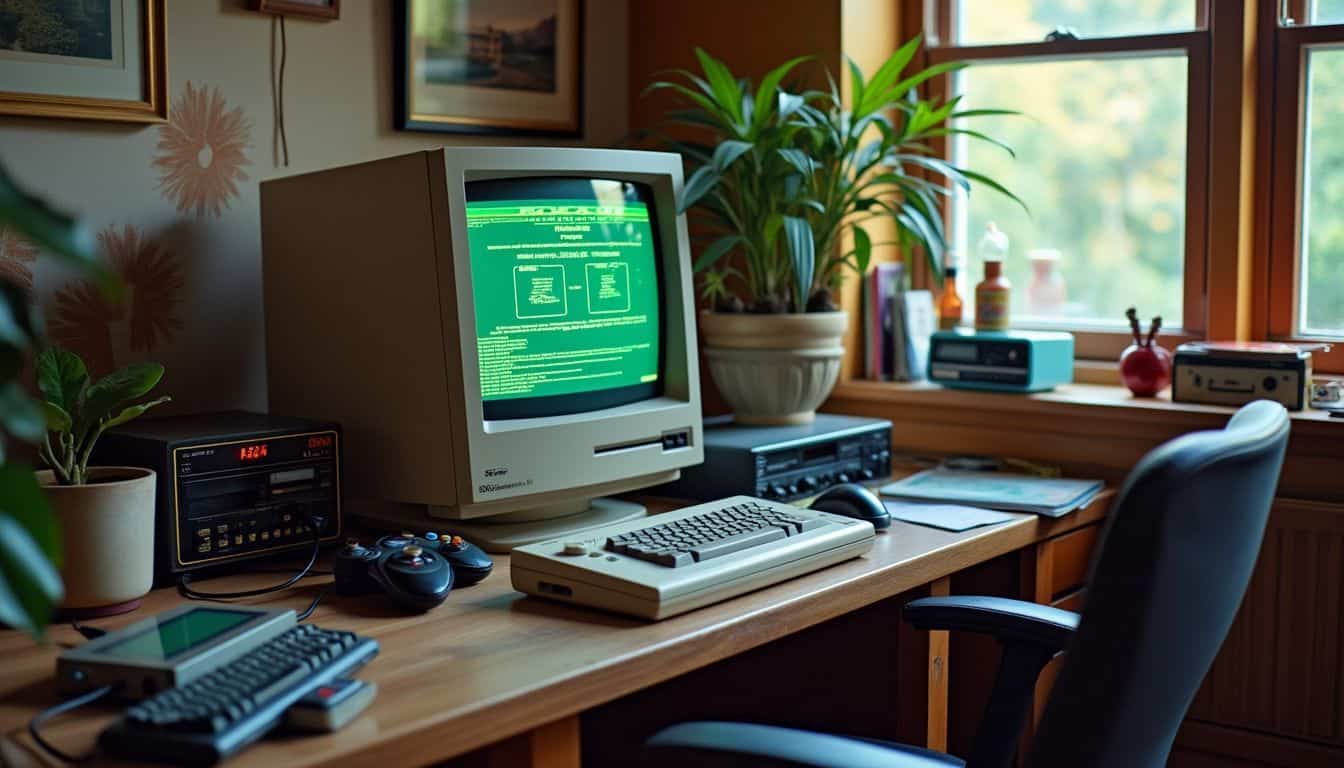
Online gaming pioneers blazed trails in the 1990s. They created games that changed how we play and connect online forever.
The Impact of Doom (1994-1995)

Doom burst onto the scene in December 1993, changing gaming forever. 9 This first-person shooter rocked the world with its fast-paced action and gory graphics. But it wasn’t just about solo play.
Doom brought us “death match” mode – a game-changer for multiplayer battles. Players could now duke it out in virtual arenas, blasting each other to bits. It was a blast!
John Romero and John Carmack, the brains behind Doom, didn’t stop there. They dropped Doom II: Hell on Earth in 1994, taking the mayhem to new heights. 9 These games set the bar for online multiplayer gaming. 10 They paved the way for countless shooters to come. Next up, let’s look at another game that shaped online play….
The Launch of Neverwinter Nights (1991)

Neverwinter Nights hit the scene in 1991, making waves as the first graphical multiplayer online RPG. 11 It was a big deal for us geeks back then! AOL hosted this game on their servers, giving players a taste of fantasy adventures with friends. 12 The graphics weren’t fancy compared to now, but man, it was mind-blowing at the time.
For six years, from ’91 to ’97, Neverwinter Nights kept us glued to our screens. It laid the groundwork for the online games we love today. I remember staying up late, exploring dungeons and battling monsters with pals across the country.
Good times! This game really kicked off a new era in digital play, showing us what online gaming could be.
The Introduction of Meridian 59 (1996)
Meridian 59 burst onto the scene in 1996, changing online gaming forever. This groundbreaking title was the first 3D online game, giving players a taste of immersive virtual worlds.
It hit the market on September 27, 1996, after a soft launch in December 1995. 13
Meridian 59 wasn’t just about fancy graphics. It packed cool features like in-game email and guild voting systems. These tools helped players connect and work together in new ways.
The game set the stage for future online worlds, showing what was possible when you mix 3D environments with social gameplay. 14
The Debut of Ultima Online (1997)
After Meridian 59 paved the way, Ultima Online burst onto the scene. This game changed everything. On September 24, 1997, Richard Garriott and his team unleashed a virtual world like no other.
It was a big deal. Players could be anyone they wanted in a huge, living fantasy land. 15
Ultima Online hit the ground running. Within six months, it had 100,000 paying subscribers. That’s a lot of folks! The game cost $2.5 million to make, but it paid off big time. Players loved the freedom to craft, fight, and explore.
It wasn’t just a game – it was a whole new way to play online. 16
Ultima Online wasn’t just a game, it was a revolution in how we play together, said a long-time fan.
The Evolution Toward Modern Online Gaming
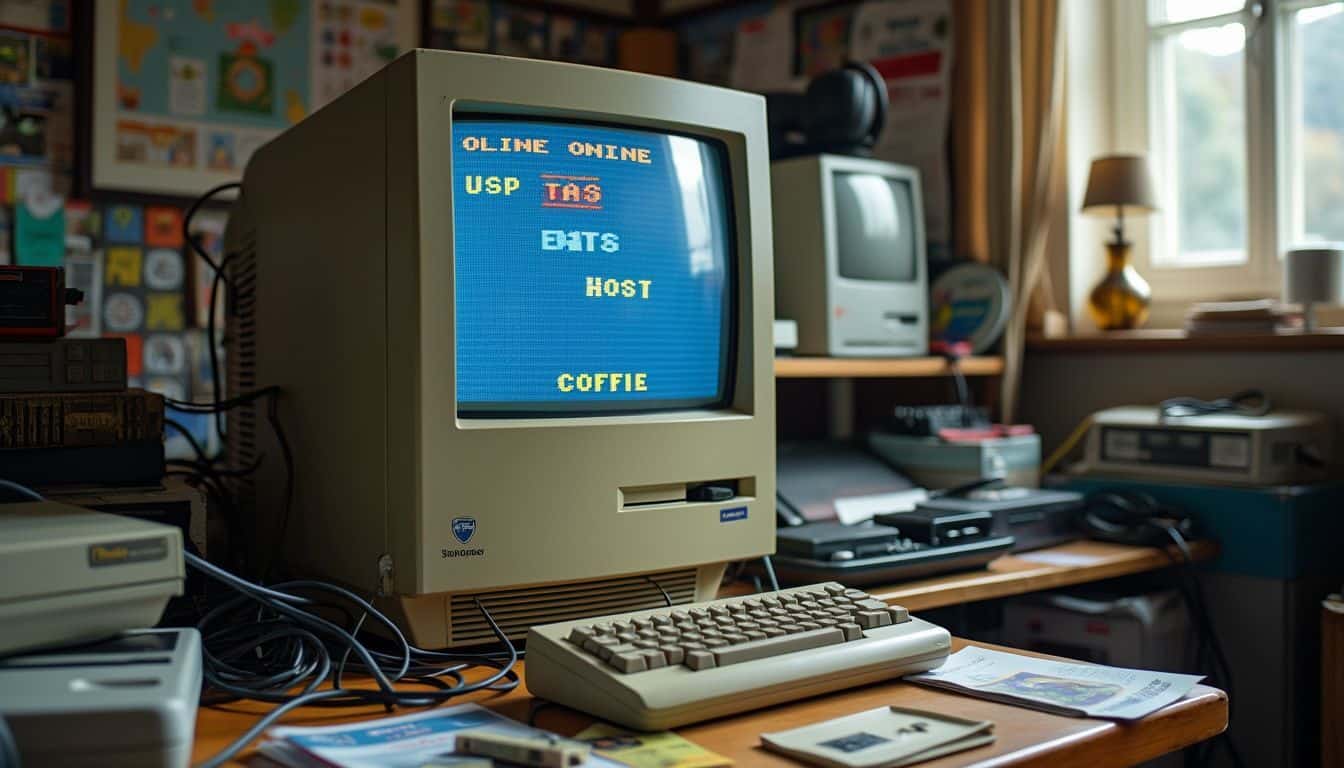
Online gaming grew up fast – from simple text games to huge virtual worlds. Want to know how we got here? Keep reading!
The Growth of MMOGs (Massively Multiplayer Online Games)
MMOGs exploded in popularity during the late 1990s and early 2000s. These games let thousands of players explore vast digital worlds together. Neverwinter Nights, launched in 1991, paved the way as the first graphical MMORPG. 17 But it was World of Warcraft’s 2004 debut that truly set the genre on fire.
WoW’s success sparked a boom in MMOGs. Suddenly, gamers could team up with friends to slay dragons or going AFK in bustling virtual cities.
The social aspect hooked players for hours on end. 18 As internet speeds improved, these games got bigger and more complex. Free-to-play models emerged in the 2000s, opening MMOGs to even more players.
This growth changed how we think about online gaming forever. 17
The Development of Virtual Economies
Virtual economies in online games have come a long way. Players can now earn, trade, and spend digital cash just like in the real world. It’s pretty wild! 19 These in-game markets mirror actual economic principles.
You might find yourself farming gold or crafting rare items to sell. Some folks even make a living off this stuff!
Virtual economies are the new frontier of digital play. 20
But it’s not all fun and games. The rise of microtransactions changed everything. Now you can buy power-ups or cool skins with real money. This has sparked debates about fairness and pay-to-win models.
Legal and ethical questions pop up too. Who owns that epic sword you bought? Can you cash out your virtual coins? It’s a brave new world out there in the pixelated marketplace!
The Role of Social Gaming
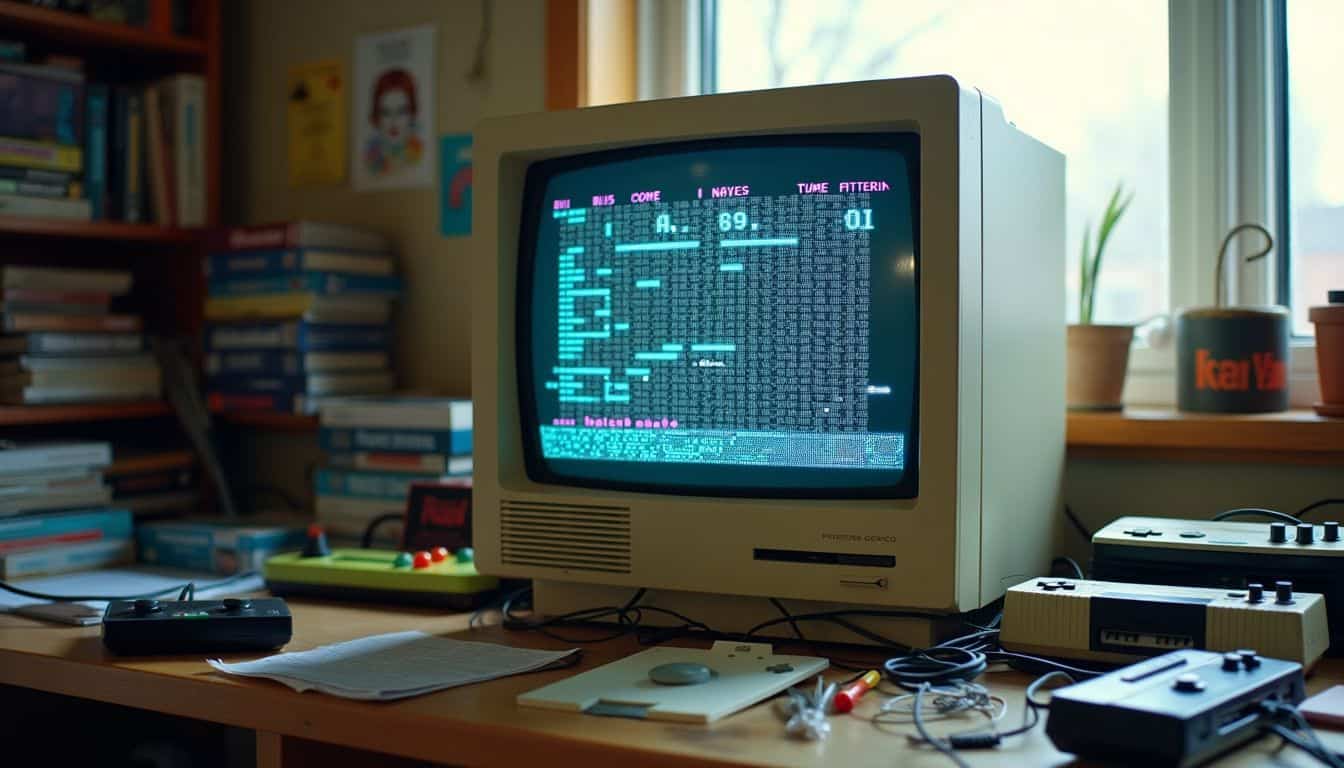
Social gaming changed how we play online. It brought games to Facebook and made gaming more social. Want to know how it all started? Keep reading!
Social Media Integration
Social networks changed online gaming big time. Games now link to Facebook, Twitter, and other platforms. This lets players share scores, invite friends, and brag about wins. It’s made gaming more social and spread it to new groups. 21
Game makers use social media to build buzz and keep fans hooked. They post updates, run contests, and chat with players. This creates a community feel around games. Next up, we’ll look at how social gaming broadened who plays. 22
Broadening Gaming Demographics
Gaming isn’t just for kids anymore. It’s grown up, and so has its audience. Four out of five U.S. homes now have a game console. 8 That’s a huge jump from the early days. People of all ages, genders, and backgrounds are picking up controllers.
Moms, dads, and even grandparents are joining in the fun.
This shift has changed how games are made. Companies are creating titles that appeal to a wider range of folks. Simple mobile games have pulled in casual players. Social games on Facebook have hooked older adults.
And fitness games? They’ve got everyone moving. It’s not just about high scores anymore – it’s about connecting, learning, and staying active. 23
Predictions for Online Gaming

Online gaming’s future looks wild – think VR headsets and mobile madness! Want to know more? Keep reading…
The Shift to Mobile Gaming
Mobile gaming has taken the world by storm. It’s changed how we play and when we play. Gone are the old days of gaming where we needed a big console or PC.
Now, we carry powerful gaming devices in our pockets. But it’s not all smooth sailing. In 2022, the mobile gaming market shrank by 6%. That’s a big deal for an industry that was always growing. 24
What’s next for mobile gaming? Well, companies are getting creative. They’re mixing up how they make money from games. Netflix is jumping in too. They plan to release at least one free-to-play mobile game in 2023.
It’s a smart move. 24 More people are playing on their phones than ever before. And with new tech like 5G, mobile games are only going to get better and faster. It’s an exciting time for gamers and game makers alike. 25
Innovations in Virtual Reality and Augmented Reality
As mobile gaming grows, virtual and augmented reality are taking center stage. These techs are changing how we play and interact with games. VR headsets like Oculus Rift, which came out in 2016, let players step into digital worlds.
It’s like being inside the game! AR apps use your phone’s camera to add digital elements to the real world.
VR and AR are pushing gaming limits. In 2013, Oculus VR started up. Facebook bought them in 2014, showing how big this field could be. Now, we’re seeing games with super-real 3D graphics that you can touch and move in. 26 It’s not just for fun – these tools help train workers and even let doctors practice surgeries. The future of gaming looks wild! 7
People Also Ask
What was the first online game?
MazeWar, a shooter game from 1974, kicked off online gaming. It used packet-based computer networking to connect players. This paved the way for future multiplayer games.
How did consoles join the online gaming party?
Consoles jumped on the bandwagon in the late 90s. The Sega Dreamcast led the charge with its built-in modem. Soon after, PlayStation 2 and Xbox Live brought online console gaming to the masses.
What role did MMORPGs play in shaping online gaming?
MMORPGs like EverQuest and Lineage were game-changers. They created virtual worlds where thousands could play together. These games introduced in-game currencies and virtual economies, sparking the rise of “gold farmers.”
How did LAN parties contribute to online gaming culture?
LAN parties were the cool kids of the 90s gaming scene. Gamers lugged their PCs to a friend’s house, linking up for epic battles in games like StarCraft. These gatherings laid the groundwork for today’s esports events.
What impact did broadband internet have on online gaming?
Broadband was a total game-changer. It allowed for smoother gameplay and richer graphics. Games like Halo 2 on Xbox Live took full advantage, setting new standards for online multiplayer experiences.
How have mobile devices affected online gaming?
Smartphones and tablets have turned everyone into potential gamers. From Candy Crush to Pokémon GO, mobile games have exploded in popularity. They’ve brought online gaming to folks who never touched a console or PC before.
References
^ https://grainger.illinois.edu/news/magazine/plato
^ https://distributedmuseum.illinois.edu/exhibit/plato_impacts/
^ https://en.wikipedia.org/wiki/Multi-user_dungeon
^ https://massivelyop.com/2019/10/26/the-game-archaeologist-a-brief-history-of-multi-user-dungeons/ (2019-10-26)
^ https://medium.com/@datapath_io/the-history-of-online-gaming-2e70d51ab437
^ https://en.wikipedia.org/wiki/History_of_online_games
^ https://www.sciencedirect.com/science/article/pii/S2772503023000609
^ https://techcrunch.com/2015/10/31/the-history-of-gaming-an-evolving-community/ (2015-10-31)
^ https://www.britannica.com/topic/Doom
^ https://gaminghistory101.com/2016/05/10/doom-retrospective/ (2016-05-10)
^ https://en.wikipedia.org/wiki/Neverwinter_Nights_(1991_video_game)
^ http://crpgaddict.blogspot.com/2017/02/game-241-neverwinter-nights-1991.html (2017-02-15)
^ https://sites.google.com/site/meridian59history/
^ https://en.wikipedia.org/wiki/Meridian_59
^ https://en.wikipedia.org/wiki/Ultima_Online
^ https://community.stratics.com/threads/a-uo-facelift-idea.430782/ (2023-10-17)
^ https://en.wikipedia.org/wiki/History_of_massively_multiplayer_online_games
^ https://www.ncbi.nlm.nih.gov/pmc/articles/PMC8277937/
^ https://www.gamespace.com/all-articles/news/understanding-virtual-economies-in-online-gaming/
^ https://www.ncbi.nlm.nih.gov/pmc/articles/PMC10807828/
^ https://www.researchgate.net/publication/337144821_The_Impact_of_Social_Media_on_Video_Game_Communities_and_the_Gaming_Industry
^ https://medium.com/@andreeab7/37-from-gaming-to-socializing-the-emergence-of-social-media-platforms-for-gamers-82d96e2001f0
^ https://www.ncbi.nlm.nih.gov/pmc/articles/PMC4080869/
^ https://mobiledevmemo.com/2023-predictions-for-mobile-gaming/
^ https://www.ncbi.nlm.nih.gov/pmc/articles/PMC9379297/
^ https://medium.com/@Najeeb/vr-innovation-adoption-gaming-historical-perspective-21b2a14532f5
